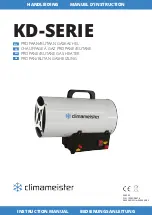
46
KCM Series Manual
Final Checklist
□
The water heater is not subject to corrosive
compounds in the air.
□
Water supply does not contain chemicals or
exceed total hardness referenced in manual.
□
Clearances from the water heater unit are met.
□
Clearances from vent termination are met.
□
For indoor models, ensure you have used the
correct venting products for the model installed
and that you have completely followed the
venting manufacturer’s installation instructions
and these installation instructions.
□
For indoor models, verify that the vent system
does not exceed the maximum length for the
number of elbows used.
□
For indoor models, verify that SW 1 in DIPSW 1
has been adjusted for vent length if necessary.
Refer to the section on Maximum Vent Length.
□
For indoor models, ensure SW4 in DIPSW 2 is set
to the appropriate venting style.
□
Purge water line of all debris and air by closing
hot isolation valve and opening the cold isolation
valve and its drain.
Debris will damage the water
heater.
Use a bucket or hose if necessary.
□
Ensure that hot and cold water lines are not
crossed to the unit and are leak free.
□
A manual gas control valve has been placed in the
gas line to the water heater.
□
Ensure a pressure relief valve is properly installed
with a rating that exceeds the BTU input of the
water heater model. Refer to the rating plate on
the side of the water heater for BTU input.
□
Clean the inlet water filter by closing the cold and
hot water inlet isolation (shut-off) valves. Put a
bucket under the filter at the bottom of the water
heater to catch any water that is contained inside
the unit. Unscrew the water filter. Rinse the filter
to remove any debris. Install the filter and open
the isolation valves.
□
Check the gas lines and connections for leaks.
□
Confirm that the gas inlet pressure is within
limits.
□
Confirm that the water heater is rated for the gas
type supplied.
□
Confirm that the electricity is supplied from a 120
VAC, 60 Hz power source, is in a properly
grounded circuit, and turned on.
□
Verify the temperature controller or status
monitor is functioning properly.
□
Verify that SW3 in DIPSW 1 is set correctly for
your altitude.
□
Verify the system is functioning correctly by
connecting your manometer to the gas pressure
test port on the water heater. Operate all gas
appliances in the home or facility at high fire. The
inlet gas pressure at the water heater must not
drop below that listed on the rating plate.
□
DO NOT
introduce toxic chemicals such as those
used for boiler water treatment to the potable
water used for space heating.
□
If the water heater is not needed for immediate
use, drain the water from the heat exchanger.
□
Install the front panel.
□
Explain to the customer the importance of not
blocking the vent termination or air intake.
□
Explain to the customer the operation of the
water heater, safety guidelines, maintenance, and
warranty.
□
The installation must conform with local codes or,
in the absence of local codes, with the
National
Fuel Gas Code, ANSI Z223.1/NFPA 54
, or the
Natural Gas and Propane Installation Code, CSA
B149.1
. If installed in a manufactured home, the
installation must conform with the
Manufactured
Home Construction and Safety Standard, Title 24
CFR, Part 3280
and/or
CAN/SCA Z240 MH Series,
Mobile Homes
.
□
Inform the consumer if the isolation valves are
not installed or if a water softening system is not
installed.
□
Leave the entire manual taped to the water
heater (indoor units) or give the entire manual
directly to the consumer.
Summary of Contents for RUCS65i series
Page 50: ...50 KCM Series Manual Ladder Diagram EXHAUST...
Page 132: ...100000384 3 2015...
















































